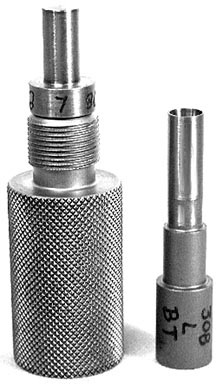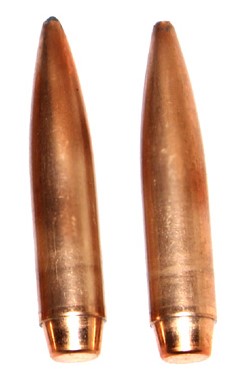|
|
|
Jacket tip closer, type -S
|
| |

|
Quantity in Basket:
None
Catalog No.: LT-1-SC
Price: $249.00
Shipping Weight: 0.25 pounds
Sorry, we are no longer taking orders for the Jacket tip closer, type -S on our legacy website. Please visit our new website at Corbins.com for all future orders. Any question/concerns you can reach us at sales@corbins.com Thank you
|
| |
The Jacket Tip Closer is used to reduce the opening size (meplat) in an open tip jacketed bullet. It is commonly calle a tip closer die, but the amount of meplat diameter reduction possible depends on the jacket hardness, thickness, and the ogive shape, as well as the amount of core filling the jacket to support it. In most cases, a typical open tip bullet can have the tip opening reduce by at least half its diameter. In a few cases, the opening can actually be closed. The actual reduction amount is NOT an absolute unvariable percentage. Different jackets will collapse, fold, or pick up a ring or step if you try to close the tip further than the material strength and resistance will allow. In nearly all instances, however, the Jacket Tip Closer will improve the BC of a given open tip bullet regardless of whether the tip can be completely closed or reduced in size.
This die is actually a conventional lead tip die, with a flat base or rebated boattail external punch, but equipped with a special hardened internal punch engineered to apply force vectored toward the end of the jacket in a given ogive shape. The caliber and the ogive shape are unique to a given die and punch. But the same caliber of bullet can be used in the same die with different ogive shapes IF you change the internal punch to match the new shape. (By "match", we mean provide a punch that will first touch the very edge of the jacket, not a punch with exactly the same ogive shape as in a conventional lead tip internal punch. Using an exact duplicate of the ogive shape would not apply more force toward the open end, and would just shove the same curve backward into the existing ogive, making step in the nose shape.)
If you already have a lead tip die, in the appropriate caliber, you can change the internal punch and use the LT-1-S die as a Jacket Tip closer. The internal punch for jacket tip closing is designated as "PUNCH-SJ". It requires the use of a different kind of tool steel, to handle the localized force with long wear life, and is also heat treated for greater hardness than a conventional lead tip punch. The geometry of the cavity is also different from a standard lead tip punch in the same caliber and ogive shape. The amount of work invested in each of these special punches is over twice as long as it takes to make a conventional lead tip internal punch.

|
|








































